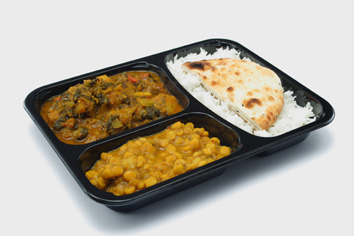Modified Atmosphere Packaging of Prepared Foods and Ready Meals

Modern convenience foods, such as ‘ready meals’ packed in trays, sometimes with several compartments containing different meat or vegetable dishes, are becoming increasingly popular. These sit alongside more traditional ready-prepared foods such as pizzas and sandwiches. The shelf life of these ready meals can be significantly prolonged by modified atmosphere packaging (MAP), but there are major challenges in developing the best packaging materials and gas mixtures.
The problem with such food products is the variety of foodstuffs contained within a single package. A simple pizza for example has a dough base together with a cheese topping. Each of these deteriorates in a different way. On their own they would have a different MAP regime. Together a compromise gas mixture must be found. The system becomes even more complicated for exotic tray-packed ready meals or elaborate sandwiches with a variety of fillings.

Nevertheless, modified atmosphere packaging experts can devise the best way of preserving such multi-component foods. For example reduced oxygen level coupled with higher carbon dioxide and nitrogen can add five or six days to the shelf life of many types of sandwich. Tests have shown that the shelf life of ready meals and ‘cook chill’ products (food that has been prepared and cooked before being rapidly chilled to a few degrees then stored at a low temperature before being re-heated by the consumer) can be increased from between two and five days to between five and ten days if modified atmosphere packaging is used.
In addition, modified atmosphere packaging has been shown to delay the onset of a characteristic phenomenon related to pre-cooked meat and poultry known as ‘oxidative warmed over flavour’, a stale off-taste that can develop with such foodstuffs within a couple of days if they are stored in air. Low oxygen levels have been shown to delay the development of this taste.
The problem with such food products is the variety of foodstuffs contained within a single package. A simple pizza for example has a dough base together with a cheese topping. Each of these deteriorates in a different way. On their own they would have a different MAP regime. Together a compromise gas mixture must be found. The system becomes even more complicated for exotic tray-packed ready meals or elaborate sandwiches with a variety of fillings.
Nevertheless, modified atmosphere packaging experts can devise the best way of preserving such multi-component foods. For example reduced oxygen level coupled with higher carbon dioxide and nitrogen can add five or six days to the shelf life of many types of sandwich. Tests have shown that the shelf life of ready meals and ‘cook chill’ products (food that has been prepared and cooked before being rapidly chilled to a few degrees then stored at a low temperature before being re-heated by the consumer) can be increased from between two and five days to between five and ten days if modified atmosphere packaging is used.
In addition, modified atmosphere packaging has been shown to delay the onset of a characteristic phenomenon related to pre-cooked meat and poultry known as ‘oxidative warmed over flavour’, a stale off-taste that can develop with such foodstuffs within a couple of days if they are stored in air. Low oxygen levels have been shown to delay the development of this taste.




